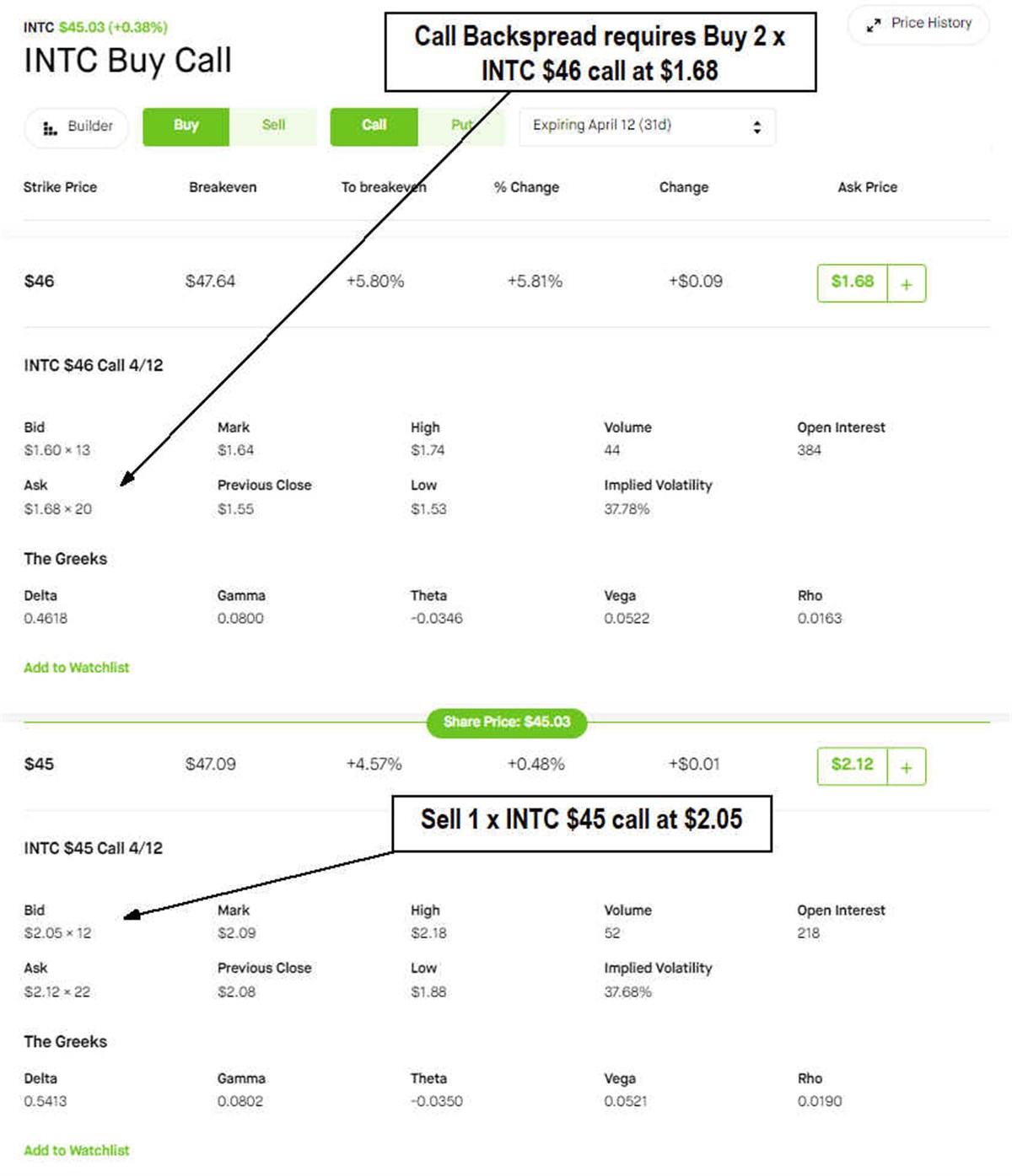
Key Points
- A bull call backspread limits your max risk without capping your max gains.
- A bull call backspread strategy can be used when you are very bullish on a stock and expect a sharp upside move.
- It is a multi-leg strategy comprised of a ratio of 1:2, selling 1 ATM or ITM call and buying 2 OTM calls.
- 5 stocks we like better than Intel
Options trading strategies such as call debit spreads can be used to help mitigate potential losses in exchange for capping potential upside gains. They also enable you to enter a bullish directional trade at a discount compared to just buying long a call option. A debit spread allows you to quantify your max risk and reward while trimming the cost of playing a long directional trade on the underlying stock. The long call is partially financed by selling the in-the-month (ITM) call.
If you are very bullish on a stock and willing to pay a little more to remove the upside cap, then you may consider a bull call backspread strategy. This works on any optionable stock in any stock sector in the stock market and offers unique investment opportunities.
The Mechanics of a Bull Call Backspread
This strategy is also referred to as a call backspread, call ratio spread, or ratio spread. The mechanics are similar, putting on a short call spread to offset the purchase of a long call. This is a 2-legged strategy.
Sell 1 at-the-money (ATM) or in-the-money (ITM) call and Buy 2 out-of-the-money (OTM) calls.
Analyzing the INTC Daily Candlestick Chart Setup
Let’s use semiconductor giant Intel Co. NASDAQ: INTC as an example. Let’s assume we are very bullish on INTC due to the artificial intelligence (AI) trend and an upcoming AI industry conference where the spotlight will be on AI chip makers.

INTC is trading at $44.99 on March 12, 2024. Since its earnings sell-off, INTC has been attempting to make higher lows and higher highs. This could result in a cup pattern formation on a rally back to the $50.15 swing high. The daily relative strength index is forming a divergence bottom where each bounce attempt happens at a higher band.
Putting on the Trade
The trigger would be a breakout through the 60-band to unlock upside momentum. We select the April 12, 2024, expiration date leaving us 31 days until expiration. We will do the $45/$46 call backspread on INTC. Since the $45 strike is at-the-money (ATM) and the $46 strike call option is out-of-the-money (OTM), these are the most formidable strikes to play for the call backspread.

To execute the call backspread strategy, we sell 1 x $45 call at $2.05 and buy 2 x $46 calls at $1.68. The 1 short $45 call results in a credit of $205. The 2 long $46 calls cost $336. The net cost of this trade is $1.31 or $131.
It’s important to have a strong setup or potential for a strong breakout with the call backspread. Shares need to surge higher than the strike price of the 2 long calls.
Possible Outcomes for Bull Call Backspread
Here are possible outcomes if the call backspread is held through expiration on April 12, 2024, based on what price INTC closes at.
If INTC closes at $50, then the short INTC $45 call is worth -$500 minus the $205 premium received for a loss of -$295. The long $46 calls are worth $4 each or $800 total minus the $336 cost of the trade is $464 profit minus the -$295 loss on the short call for a net profit of $169 or 129% gain.
If INTC closes at $48, the short INTC $45 call is worth -$300 minus the $205 premium is -$95. The 2 INTC 46 calls are worth $2 each for a total of $400 minus the $338 cost for $62 profit minus the -$95 loss resulting in a net loss of $33 or 25.2% loss. The breakeven price is an INTC close at $48.33.
If INTC closes at $47, the loss is the cost of the trade -$131 is taken.
If INTC closes at $46, the loss is the cost of the trade -$131 and the spread of $1 for a max loss of $231.
If INTC closes at $45 or below, the max loss is the cost of the trade at $131.
Best Use Cases and When to Avoid Bull Call Backspreads
Bull call backspreads are ideal in volatile stocks and markets. A fast price spike is preferred since a jump in implied volatility can jack up the premiums on the long calls, even if they're out of the money. While we use the example of waiting through the options expiration on April 12, 2024, we can opt to close out the position at any time. If INTC surges and volatility jumps, the premiums can add up.
Before you consider Intel, you'll want to hear this.
MarketBeat keeps track of Wall Street's top-rated and best performing research analysts and the stocks they recommend to their clients on a daily basis. MarketBeat has identified the five stocks that top analysts are quietly whispering to their clients to buy now before the broader market catches on... and Intel wasn't on the list.
While Intel currently has a "Hold" rating among analysts, top-rated analysts believe these five stocks are better buys.
View The Five Stocks Here
Need to stretch out your 401K or Roth IRA plan? Use these time-tested investing strategies to grow the monthly retirement income that your stock portfolio generates.
Get This Free Report